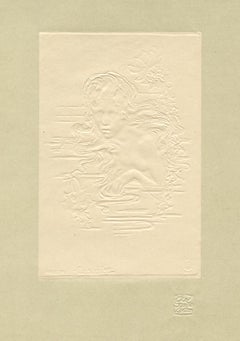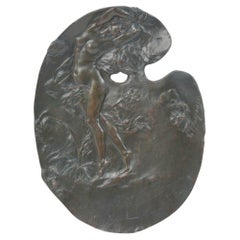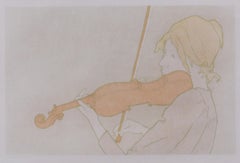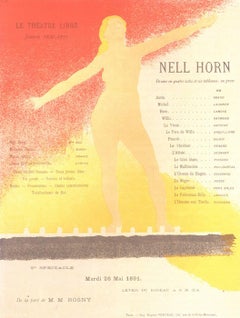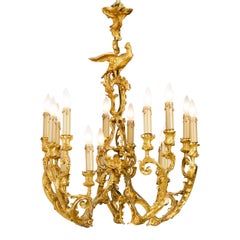Alexandre Charpentier Art
French, 1856-1909
Alexandre Charpentier was a French sculptor, medalist, craftsman and cabinet-maker. He experimented with a wide variety of formats and materials—tin, marble, wood, leather and terra cotta work, the latter executed by ceramic artisan Emile Müller. Charpentier designed many sets of furniture. Many of his custom designs for fixtures (doorknobs, door plates, window handles and the like) were subsequently mass-produced and commercially sold. Several of Charpentier's works are part of the Musée d'Orsay collection.
to
5
5
5
4
embossed engraving
By Alexandre Charpentier
Located in Henderson, NV
Medium: embossed engraving. Printed in 1897 and published in London for The Studio. Image size: 5 x 3 3/8 inches (130 x 85 mm). Sheet size: 11 x 7 5/8 inches (282 x 193 mm). This imp...
Category
1890s Art Nouveau Alexandre Charpentier Art
Materials
Engraving
Painter's Palette with Female Figure by Alexandre Charpentier (1856-1909)
By Alexandre Charpentier
Located in New York, NY
Our hanging Art Nouveau period bronze sculpture by Alexandre Charpentier (1856-1909) depicts a lovely female upon a painter's palette.
Category
Late 19th Century French Belle Époque Antique Alexandre Charpentier Art
Materials
Bronze
La Fille au Violon
By Alexandre Charpentier
Located in Fairlawn, OH
La Fille au Violon
Color lithograph, gypsograph with embossed publisher's stamp
Signed and numbered in ink (see photo)
From: L'Estampe Originale, Paris, Vol. VII
Published by Andre M...
Category
1890s Art Nouveau Alexandre Charpentier Art
Materials
Lithograph
"Grande Tuilerie d’Ivry" from Les Maitres de l'Affiche
By Alexandre Charpentier
Located in Hinsdale, IL
CHARPENTIER, ALEX
(1856 -1909)
"Grande Tuilerie d’Ivry"
Original lithograph from "Les Maitres de L'Affiche" series
Printed by Imprimerie Chaix, Paris
Bearing MDL stamp lower right, issue # 33, 1898. Plate #131
Unframed Size: 11 3/8 x 15 3/4”The
"Les Maitres de l'Affiche" series was offered as a subscription series to collectors every month for 60 months, from December 1895 through November 1900. The "Maitres de l'Affiche," were issued as separate numbered sheets, referred to as "plates". They were numbered, with the printers name "Imprimerie Chaix," in the margin at the bottom left hand corner, "PL.1" to "PL.240." In the margin at the bottom right hand corner of each, is a blind embossed stamp from a design of Cheret's. The smaller format and the fact the "Maitres" were a paid subscription series, allowed Imprimerie Chaix to use the latest state of the art printing techniques, not normally used in the large format posters due to cost. A very high quality of paper was used, where as the large format posters were printed on lesser quality newsprint, due to cost and a short expected life span. This explains why the quality of the printing, in the "Maitres de l'Affiche," usually far exceeds that of their larger counterparts. The text reads "Great Tileworks of Ivry, founded in 1854, Ivry-Port near Paris; the largest ceramics factory in the world for building, industry and art productions; Emille Muller stoneware; execution of works by masters of statuary; architectural facings; decorative sculpture; showroom and salesroom, 3 rue Halevy; the only tile able to bear the names Muller and Ivry; (tiles) guaranteed against frost" Given the commission for an extremely text heavy poster, the artist executes a masterful design. The angelic young boy holds the wares of this famous ceramics factory, against an abstract background awash in organic green hues. The handling of the immense text that flows from top to bottom in every available space shows great artistic skill, as the overall beauty of the design is intact. In 1989 the Metropolitan Museum of art acquired a stoneware plaque...
Category
1890s Art Nouveau Alexandre Charpentier Art
Materials
Lithograph
Nell Horn. Program pour Le Theatre Libre. Saison 1980-91. May 25 1891
By Alexandre Charpentier
Located in New York, NY
Embossing (gaufrage) with typographical color printing. Fine impression with good embossing on simili-japon paper, printed to the edges of the sheet (as issued). The combination of techniqes is unusual and may be unique.
Ref: Artistes et Theatre d'Avant-Garde Programmes illustres Paris 1890-1900 Aitken p 22 pl 11; Artists and the Avant-Garde Theatre in Paris 1887-1890 Boyer p.44 pl 9.
Alexandre Charpentier was French sculptor, medalist, craftsman, and cabinet-maker. He experimented with a wide variety of formats and materials—tin, marble, wood, leather, and terra cotta work, the latter executed by ceramic artisan Emile Müller...
Category
1890s Art Nouveau Alexandre Charpentier Art
Materials
Lithograph
Related Items
Jane - original lithograph (1897/98)
By Louis Rhead
Located in Paris, FR
Louis Rhead
Jane
Original lithograph
Printed signature in the plate
1897/98
On vellum 40 x 31 cm (c. 16 x 12")
INFORMATION : Published by 'Estampe Moderne, Paris, 1897-1899 and pri...
Category
1890s Art Nouveau Alexandre Charpentier Art
Materials
Lithograph
"Summer From: The Four Seasons, " Giclee Print after 1896 Print by Alphonse Mucha
By (after) Alphonse Mucha
Located in Milwaukee, WI
"Summer From: The Four Seasons" is a giclee print on photo paper after Alphonse Mucha's 1896 print of the same name. A woman lounges on a stone surrounded by vines and other pieces of nature. She rests her head on a vine and looks backward at the viewer, she is wearing a very sheer white dress...
Category
1890s Art Nouveau Alexandre Charpentier Art
Materials
Giclée, Paper
English Bar
By Louis Legrand
Located in Storrs, CT
English Bar. 1908. Etching and drypoint. Exsteens catalog 275 state ii. 8 1/8 x 5 5/8 (sheet 17 3/8 x 12 1/4). Series: Les Bars. Edition 65 in this state (total edition 95). Printed ...
Category
Early 1900s Art Nouveau Alexandre Charpentier Art
Materials
Drypoint, Etching
Petite Chupicuaro Female Figure
Located in Chicago, IL
This standing female figure was crafted in 400-100 BC from the ancient Chupicuaro region of Mexico. The ceramic works of the Chupicuaro people are distinguished by their slanted, cof...
Category
15th Century and Earlier Mexican Pre-Columbian Antique Alexandre Charpentier Art
Materials
Ceramic
French Art Deco Terracotta Nude Female with Figure of Love by Ary Bitter
By Ary Bitter
Located in Miami, FL
Ary Bitter 1883 Marseille 1973 Paris.
Gold medal in the Salon des Artistes Français in 1924.
This unique work of art is the perfect testimony of the best talented artist creation.
The representation of a Nude female with a so intense sensitivity and realism is fantastic. The woman’s and the sleeping body are in the deep dream of love...
Category
1930s French Art Deco Vintage Alexandre Charpentier Art
Materials
Terracotta
Late 19th century color engraving female figure cello musical instrument ornate
By Eugène Grasset
Located in Milwaukee, WI
"Woman with Cello" is a wood engraving by Gillot after Eugene Grasset. The artist signed the piece in the lower right. It depicts a woman with long fl...
Category
1890s Art Nouveau Alexandre Charpentier Art
Materials
Engraving
Herend Nude Sitting Female Figure
By Herend
Located in Houston, TX
Herend female nude figure, hand-painted. #5719.
Condition is perfect, circa 1960s.
Has Herend stamp on the bottom
Measures: 17.5” H x 9.5” W.
Category
Mid-20th Century Hungarian Other Alexandre Charpentier Art
Materials
Porcelain
Miss Taylor
By Paul César Helleu
Located in Fairlawn, OH
Miss Taylor
Drypoint, c. 1900
Signed in pencil lower left (see photo)
Small edition, about 10
Very rich impression, full of burr
Condition: Excellent
Image size: 21-1/4 x 13-1/4"
Sheet size: 25 3/8 x 18 5/8"
Reference: Montesquiou XII
Paul César Helleu was born in Vannes, Brittany, France. His father, who was a customs inspector, died when Helleu was in his teens. Despite opposition from his mother, he then went to Paris and studied at Lycée Chaptal. In 1876, at age 16, he was admitted to the École des Beaux-Arts, beginning academic training in art with Jean-Léon Gérôme. Helleu attended the Second Impressionist Exhibition in the same year, and made his first acquaintances with John Singer Sargent, James McNeill Whistler, and Claude Monet. He was struck by their modern, bold alla prima technique and outdoor scenes, so far removed from the studio. Following graduation, Helleu took a job with the firm Théodore Deck Ceramique Française hand-painting fine decorative plates. At this same time, he met Giovanni Boldini, a portrait painter with a facile, bravura style, who became a mentor and comrade, and strongly influenced his future artistic style.
When he was 18 years old, Helleu established a close friendship with John Singer Sargent, four years his senior, that was to last his lifetime. Already becoming established, Sargent was receiving commissions for his work. Helleu had not sold anything, and was deeply discouraged almost to the point of abandoning his studies. When Sargent heard this, he went to Helleu and picked one of his paintings, praising his technique. Flattered that Sargent would praise his work, he offered to give it to him. Sargent replied, "I shall gladly accept this, Helleu, but not as a gift. I sell my own pictures, and I know what they cost me by the time they are out of my hand. I should never enjoy this pastel if I hadn't paid you a fair and honest price for it." With this he paid him a thousand-franc note.
Helleu was commissioned in 1884 to paint a portrait of a young woman named Alice Guérin (1870–1933). They fell in love, and married on 28 July 1886. Throughout their lives together, she was his favourite model. Charming, refined and graceful, she helped introduce them to the aristocratic circles of Paris, where they became popular fixtures.
On a trip to London with Jacques-Émile Blanche in 1885, Helleu met Whistler again and visited other prominent artists. His introduction to James Jacques Tissot, an accomplished society painter from France who made his career in England, proved a revelation. In Tissot, Helleu saw, for the first time, the possibilities of drypoint etching with a diamond point stylus directly on a copper plate. Helleu quickly became a virtuoso of the technique, drawing with the same dynamic and sophisticated freedom with his stylus as with his pastels. His prints were very well received, and they had the added advantage that a sitter could have several proofs printed to give to relations or friends. Over the course of his career, Helleu produced more than 2,000 drypoint prints.
Soon, Helleu was displaying works to much acclaim at several galleries. Degas encouraged him to submit paintings to the Eighth Impressionist Exhibition in May and June 1886. The show was installed in a Paris apartment at 1 rue Laffitte, which ran concurrently with the official Salon that year to make a statement. Although 17 artists joined the famous exhibit that included the first Neo-Impressionistic works, Helleu, like Monet, refused to participate.
Paul Helleu Sketching with His Wife (1889), by John Singer Sargent, The Brooklyn Museum, New York
In 1886, Helleu befriended Robert de Montesquiou, the poet and aesthete, who bought six of his drypoints to add to his large print collection. Montesquiou later wrote a book about Helleu that was published in 1913 with reproductions of 100 of his prints and drawings. This volume remains the definitive biography of Helleu. Montesquiou introduced Helleu to Parisian literary salons, where he met Marcel Proust, who also became a friend. Proust created a literary picture of Helleu in his novel Remembrance of Things Past as the painter Elstir. (Later, Helleu engraved a well-known portrait of Proust on his deathbed.) Montesquiou's cousin, the Countess Greffulhe, enabled Helleu to expand his career as a portrait artist to elegant women in the highest ranks of Paris society, portraits that provide the basis for his modern reputation. His subjects included the Duchess of Marlborough, the Marchesa Casati...
Category
Early 1900s Art Nouveau Alexandre Charpentier Art
Materials
Drypoint
Dornröschen (Sleeping Beauty.)
By Heinrich Vogeler
Located in Storrs, CT
Reif 20.IIc(of e). 10 5/8 x 9 3/4 (sheet 19 X 12 3/4). Slight scattered foxing in the margins, away from the image. A rich, tonal impression printed on sturdy wove paper. Proof aside...
Category
Late 19th Century Jugendstil Alexandre Charpentier Art
Materials
Fiberglass, Drypoint, Etching, Aquatint
Couple Under a Tree
By Elyse Ashe Lord
Located in New York, NY
Elyse Ashe Lord (1900-1971), Couple Under a Tree, c. 1930, color etching, soft ground, drypoint; signed lower right in pencil and numbered by the artist lower left. In very good condition, the full sheet, 11 3/4 x 12 1/4, the sheet 17 x 16 inches.
A fine impression, with strong colors and plate tone. Printed on a light laid ivory Japan...
Category
1930s Art Nouveau Alexandre Charpentier Art
Materials
Etching, Drypoint
Bronze Female Figure by Anne Van Kleeck, circa 1960s
Located in St.Petersburg, FL
An unusual cast bronze sculpture by Anne Van Kleeck. Elongated figure-exaggerated and inspired by Giacometti. From the artist's estate. A note about the artist: Anne Van Kleeck was primarily known for her works in cast bronze and ceramics. She attended Ohio Wesleyan University (B.A.) and Ohio State University (M.A.) and spent several years as a professor of art in Ohio and Florida. In 1957, Anne traveled to Venice, Italy to study bronze and lost wax casting, beaten iron and mosaic techniques. During that stay she employed an Italian foundry expert and together they established a small foundry on the island of Murano where they cast bronzes for her one woman show in Venice. Van Kleecks work has won multiple awards and is owned worldwide by private collectors and museums, including the Metropolitan Museum and MOMA in New York. She was contemporaries of and exhibited with Ruth Asawa, Gary Knox Bennett...
Category
1960s American Mid-Century Modern Vintage Alexandre Charpentier Art
Materials
Aluminum
Portrait de petite fille, en buste, cheveux sur les epaules (Ellen 14 ans)
By Paul César Helleu
Located in Fairlawn, OH
Portrait de petite fille, en buste, cheveux sur les epaules (Ellen 14 ans) Portrait of a little girl, bust, hair on shoulders)
Drypoint, 1902
Signed lower right corner
Very small edition
Portrait of the artist's daughter Ellen, at age 14.
Title inscribed into the plate upper left
Brilliant impression full of burr
No stated edition, proofs only, less than 10 imps
Unidnetified collector's mark verso: Initials "PH", not in Lugt
Reference: Laran, IFF No. 390
Condition: Excellent
Image/Plate eize: 14 3/4 x 12 5/8 inches
Sheet size: 25 x 16 inches
"Paul César Helleu was born in Vannes, Brittany, France. His father, who was a customs inspector, died when Helleu was in his teens. Despite opposition from his mother, he then went to Paris and studied at Lycée Chaptal. In 1876, at age 16, he was admitted to the École des Beaux-Arts, beginning academic training in art with Jean-Léon Gérôme. Helleu attended the Second Impressionist Exhibition in the same year, and made his first acquaintances with John Singer Sargent, James McNeill Whistler, and Claude Monet. He was struck by their modern, bold alla prima technique and outdoor scenes, so far removed from the studio. Following graduation, Helleu took a job with the firm Théodore Deck Ceramique Française hand-painting fine decorative plates. At this same time, he met Giovanni Boldini, a portrait painter with a facile, bravura style, who became a mentor and comrade, and strongly influenced his future artistic style.
When he was 18 years old, Helleu established a close friendship with John Singer Sargent, four years his senior, that was to last his lifetime. Already becoming established, Sargent was receiving commissions for his work. Helleu had not sold anything, and was deeply discouraged almost to the point of abandoning his studies. When Sargent heard this, he went to Helleu and picked one of his paintings, praising his technique. Flattered that Sargent would praise his work, he offered to give it to him. Sargent replied, "I shall gladly accept this, Helleu, but not as a gift. I sell my own pictures, and I know what they cost me by the time they are out of my hand. I should never enjoy this pastel if I hadn't paid you a fair and honest price for it." With this he paid him a thousand-franc note.
Helleu was commissioned in 1884 to paint a portrait of a young woman named Alice Guérin (1870–1933). They fell in love, and married on 28 July 1886. Throughout their lives together, she was his favourite model. Charming, refined and graceful, she helped introduce them to the aristocratic circles of Paris, where they became popular fixtures.
On a trip to London with Jacques-Émile Blanche in 1885, Helleu met Whistler again and visited other prominent artists. His introduction to James Jacques Tissot, an accomplished society painter from France who made his career in England, proved a revelation. In Tissot, Helleu saw, for the first time, the possibilities of drypoint etching with a diamond point stylus directly on a copper plate. Helleu quickly became a virtuoso of the technique, drawing with the same dynamic and sophisticated freedom with his stylus as with his pastels. His prints were very well received, and they had the added advantage that a sitter could have several proofs printed to give to relations or friends. Over the course of his career, Helleu produced more than 2,000 drypoint prints.
Soon, Helleu was displaying works to much acclaim at several galleries. Degas encouraged him to submit paintings to the Eighth Impressionist Exhibition in May and June 1886. The show was installed in a Paris apartment at 1 rue Laffitte, which ran concurrently with the official Salon that year to make a statement. Although 17 artists joined the famous exhibit that included the first Neo-Impressionistic works, Helleu, like Monet, refused to participate.
Paul Helleu Sketching with His Wife (1889), by John Singer Sargent, The Brooklyn Museum, New York
In 1886, Helleu befriended Robert de Montesquiou, the poet and aesthete, who bought six of his drypoints to add to his large print collection. Montesquiou later wrote a book about Helleu that was published in 1913 with reproductions of 100 of his prints and drawings. This volume remains the definitive biography of Helleu. Montesquiou introduced Helleu to Parisian literary salons, where he met Marcel Proust, who also became a friend. Proust created a literary picture of Helleu in his novel Remembrance of Things Past as the painter Elstir. (Later, Helleu engraved a well-known portrait of Proust on his deathbed.) Montesquiou's cousin, the Countess Greffulhe, enabled Helleu to expand his career as a portrait artist to elegant women in the highest ranks of Paris society, portraits that provide the basis for his modern reputation. His subjects included the Duchess of Marlborough, the Marchesa Casati, Belle da Costa Greene, Louise Chéruit, and Helena Rubinstein.
Looking for new inspiration, Helleu began a series of paintings and color prints of cathedrals and stained glass windows in 1893, followed by flower studies and landscapes of parks in Versailles. Helleu took up sailing, owning four yachts over his life. Ships, harbor views, life at port in Deauville, and women in their fashionable seaside attire became subjects for many vivid and spirited works.
In 1904, Helleu was awarded the Légion d'honneur and became one of the most celebrated artists of the Edwardian era in both Paris and London. He was an honorary member in important beaux-arts societies, including the International Society of Painters, Sculptors, and Engravers, headed by Auguste Rodin, and the Société Nationale des Beaux-Arts.
On his second trip to the United States in 1912, Helleu was awarded the commission to design was the ceiling decoration in New York City's Grand Central Terminal. He decided on a mural of a blue-green night...
Category
Early 1900s Art Nouveau Alexandre Charpentier Art
Materials
Drypoint
Previously Available Items
Rococo Revival Bronze Chandelier
By Alexandre Charpentier
Located in New Orleans, LA
This stunning French bronze ormolu chandelier is almost certainly the work of artist Alexandre Charpentier. Crafted entirely of gilded bronze, this striking light is a masterpiece of...
Category
19th Century French Rococo Revival Antique Alexandre Charpentier Art
Materials
Bronze, Ormolu
Charpentier French Art Nouveau Silvered Bronze Covered Box
By Alexandre Charpentier
Located in New York, NY
A French Art Nouveau silvered bronze figural covered box by Alexandre Charpentier.
A similar object is pictured in: The Paris Salons 1895-1915, Vol. V: Objects d’Art and Metalwar...
Category
Early 20th Century French Art Nouveau Alexandre Charpentier Art
Materials
Bronze
Charpentier French Art Nouveau Covered Box
By Alexandre Charpentier
Located in New York, NY
A French Art Nouveau patinated bronze figural covered box by Alexandre Charpentier. The lid of the box is decorated with the head and torso of a nude woman resting in a body of water...
Category
Early 1900s French Art Nouveau Antique Alexandre Charpentier Art
Materials
Bronze
Alexandre Charpentier art for sale on 1stDibs.
Find a wide variety of authentic Alexandre Charpentier art available for sale on 1stDibs. If you’re browsing the collection of art to introduce a pop of color in a neutral corner of your living room or bedroom, you can find work that includes elements of orange and other colors. You can also browse by medium to find art by Alexandre Charpentier in lithograph, engraving and more. Not every interior allows for large Alexandre Charpentier art, so small editions measuring 4 inches across are available. Customers who are interested in this artist might also find the work of Eugène Delâtre, Lucien Levy-Dhurmer, and François-Louis Schmied. Alexandre Charpentier art prices can differ depending upon medium, time period and other attributes. On 1stDibs, the price for these items starts at $200 and tops out at $2,200, while the average work can sell for $1,038.
